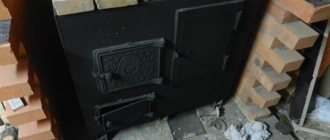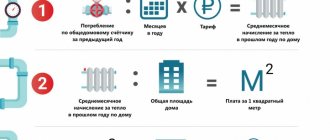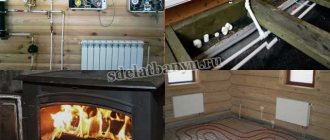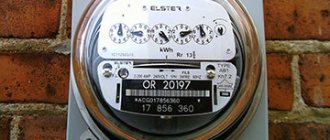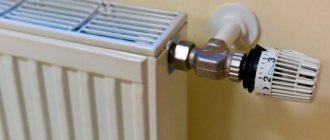About turning off batteries for the summer
Any water heating system must be filled with coolant year-round.
Getting air inside as a result of its emptying will not lead to anything good - all steel elements will begin to actively corrode until the moisture leaves. Given the enclosed space, this will not happen soon, and the empty pipes will be covered with a layer of rust from the inside. In centralized systems, it is impossible to understand whether there is water in the batteries in the summer; one can only hope for the integrity of the relevant services. As practice shows, you only need to rely on yourself. Therefore, in order to extend the service life of heating devices and prevent them from emptying, you need to choose the right moment at the very end of the heating season and turn off the valve on the battery installed on the outlet pipe. In the event of some repair work on heating networks, workers can drain water from the riser, but it will not leave the closed radiator.
Advice. You don’t have to worry at all about whether you need to shut off the radiators in the summer when your apartment has heating appliances made of cast iron. Unlike other materials, cast iron is practically not subject to corrosion.
At the time of the autumn start-up of centralized heating, particles of dirt and rust move through the pipelines along with the coolant. Steel, aluminum and bimetallic batteries have small channel widths, which can become clogged quite quickly. So on the first day of launch, when you can hear the murmur of water in the pipes, you should not rush and open the taps. It is better to do this the next day, bleeding the air using the Mayevsky tap.
There is often a warning on the Internet that in the summer only one valve to the battery should be closed, two - under no circumstances. Some say that after cooling, the water will decrease in volume and a vacuum will form in the radiator, causing it to crack (an example is given of a plastic bottle without air). Others say that the rupture will occur due to chemical reactions in aluminum batteries and the release of oxygen in all others. Excessive pressure will appear, which will supposedly rupture the device.
Such statements have no basis. The lowest operating pressure is for cast iron batteries and is 9 Bar, the destruction pressure is even higher. Not a single chemical reaction of the coolant with any metal can create such excess pressure, but for aluminum radiators the limit is even higher - 16 Bar. The example with a vacuum does not stand up to criticism at all; if it suddenly forms, then the force of external influence on the walls of the battery will be 1 Atm, that is, 1 Bar.
Who should do maintenance and repairs and when?
According to the above standards, the repair and replacement of heating devices related to common property is assigned to management companies, whose property is the entire heating system in the house, if this heating network does not have boundaries within the apartments (shut-off valves).
The article “Maintenance and repair of common property” can be found in the receipt for payment of services, according to which the owners of apartment buildings pay a monthly fee for the maintenance of this property (how is the heating fee determined?). The management company should seek funds for the repair and replacement of batteries and other communications included in the heating system from this fund.
We figured out who should do the repairs. Now let’s talk about when such equipment should be changed or repaired. In case of emergency - immediately.
The homeowner should not pay for these services to plumbers or other persons.
The issue of replacing radiators is more complicated. Here you should rely on GOSTs and other standards that determine the service life of batteries.
How to turn off the radiator in an apartment
Almost all work with elements of the heating system requires turning off the radiators, and sometimes even dismantling them. Even such a relatively simple operation as painting. performed on a cold surface. It is easier to do it after removing the radiator, this ensures full access from all sides. If more complex operations are required, such as replacing or repairing a radiator, then you need to know how to shut off the radiator.
The task of turning off the radiator is complicated by the fact that there is coolant inside it all year round. Draining water from the heating system is carried out only in case of repair, since leaving the radiator without coolant for a long period of time leads to corrosion.
The fluids inside the radiator contain small amounts of dissolved oxygen. After a certain period, all the oxygen contained in the water reacts with the metal elements of the heating system and corrosion stops. After the coolant is drained, air enters the system and, in combination with water vapor, especially hot water, corrosion intensifies. Therefore, it is correct to drain the coolant only in exceptional cases.
conclusions
Services for disconnecting water supply risers for the purpose of carrying out any work on the individual property of the owner of the premises are performed by the management company/homeowners association outside the scope of services and work on the maintenance of residential premises and are subject to separate payment by the owner, on the initiative and for whose purposes such services are provided. The cost of such services is determined by the organization (UO/HOA) that services the common property of the house, and must meet the requirements of Law 135-FZ.
presented in this article is confirmed by a number of judicial acts, including: 1. Appeal ruling of the Moscow City Court dated June 24, 2013 in case No. 11-19160\13 ; 2. Decision of the Sovetsky District Court of Krasnoyarsk dated July 12, 2011 in a civil case on the claim of the prosecutor of the Sovetsky District of Krasnoyarsk in the interests of an indefinite number of persons against Enterprise Zhilremservis LLC on recognizing illegal the actions of collecting fees from citizens for performing work to disconnect risers hot and cold water supply; 3. Resolution of the Sixth Arbitration Court of Appeal dated September 13, 2013 No. 06AP-3487/2013 in case No. A73-4100/2013 .
Author: Nifontov D.Yu.
hot water 22 housing maintenance 18 hot water 3 water supply 11
Did you like the article?
Subscribe to stay updated on current articles and the most important housing and communal services news.
Bypass device and its functions
In winter, it is not allowed to close the common riser, with the exception of emergency situations. The presence of a bypass allows you to carry out repairs without turning off the heating system of your neighbors. The device is made of pipes with a smaller diameter than the supply and discharge lines. Two ball valves allow you to properly shut off the battery even if it’s hot, directing the water circulation through the bypass.
When replacing the radiator, the water is shut off, and after the work is completed, it opens again. If the room is hot, the bypass again allows you to temporarily shut down the system: hot water stops flowing into the battery and the room is cooled. But it is better to install thermostatic valves to regulate the temperature, maintaining a normal temperature in the room.
Using such a device, the radiator can be properly disconnected from the system at any time if it is necessary to perform painting, washing, replacing batteries, as well as when changing gaskets and nipples without blocking the risers.
Correct Bypass Installation
The bypass functions, depending on the type of heating system, are as follows:
- Energy carrier adjustment. When the room temperature is higher than normal, the thermostat reduces the supply of hot water, which negatively affects the operation of the entire system. This device is used to return coolant that did not enter the battery into the system.
- Emergency adjustment of coolant circulation in a system with an electric pump. When a power failure occurs, a bypass with a valve closes the hot water supply tap to the pump through the bypass pipe, at which time the valve opens and the coolant is directed through the central pipe. In this simple way, the system goes into a state of natural circulation without the participation of a pump.
- Reanimation of a single-pipe system. It works quite effectively: apartments are warm, even hot. The bypass also helps out in this situation, allowing you to reduce the supply of hot water, thus acting as a thermostat.
Thermostat on the radiator
The bypass must be installed next to the radiator. It is recommended to make the bypass pipe directly on site during installation using a welding machine. You can also use ready-made equipment on threaded connections. The control valve or radiator thermostat must be located between the radiator inlet and the bypass.
The supply side is equipped with a valve with a thermal head.
forced paid dismantling of heated towel rail pipes is the Criminal Code right?
Recently we became happy hostages of a mortgage, but not even half a year had passed when a plumber came from the management company to check the hot water supply, after which they gave a decree on the need to dismantle the pipes of the heated towel rail, and this work would cost: 6,000 rubles for the work of the plumber and 1,000 rubles for the materials. Background: hot water in the house heats up very slowly (often it is necessary to flush 100 liters down the drain before the water warms up to a sensibly warm level). House born in 86, series P-44. It is logical that appeals were received to the management company and a plumber visited all apartments on this hot water riser in order to identify and further eliminate the cause. Some or other violations were eventually identified in a good half of the apartments, but that’s not what we’re talking about.
The structure of the passage of water through the hot water supply system into our apartment: 1). through the meter to the taps (no complaints about this) 2). then the hot water flows through a common pipe, where the movement of water is blocked (by a valve, which apparently does not turn anymore, at least moderate effort is not enough, and hammering with a hammer is dangerous - the pipe may leak) and the water goes to the pipe under the heated towel rail (along walls in the bathroom and on the wall farthest from the wiring) and from the heated towel rail it already flows back into the general hot water supply (there are also 2 valves on these pipes, which no longer turn with moderate effort)
Despite the fact that the pipes of the heated towel rail could become clogged with rust inside and really poorly pass water into the general hot water supply, the following question interests us:
1). installation of this structure was already present when we purchased the apartment, respectively, because This structure grows from a common hot water supply system, and only the management company could turn off the hot water for its installation. Why are we now being asked to pay 7,000 rubles for the dismantling of this structure? 2). supposedly the layout of the house provides for a “heated towel rail” that goes under the sink right behind the wall in the bathroom (why is there a heated towel rail under the sink - to dry dirty rags??), and in general in this house you can’t hang a heated towel rail on the far wall under the hot water supply, that’s why we have Now a cold frame will hang from the wall without heating with hot water.
What to do in this situation? I don’t want to pay 7,000 rubles for other people’s problems, or lose the heating of the heated towel rail with hot water, i.e. in fact they demand to worsen the conditions, and even pay 7,000 rubles for it
If you need to shut off and remove the radiator
It is best to carry out work related to radiator removal after the end of the heating season. If work needs to be carried out during the heating season, you need to take into account a number of nuances. If you have a single-pipe heating system and vertical wiring, you can remove the battery only if there is a bypass.
Such a system can be identified by pipes, one of which comes from the ceiling and connects to the radiator, and the other comes out of the radiator and disappears into the floor. A bypass is a jumper connecting the incoming and outgoing pipes. This is a pipe of approximately the same or slightly smaller diameter than the main pipes. The principle of the bypass is as follows: if the radiator is turned off, water begins to flow through the riser, passing through the bypass, without passing through the battery. In this case, the riser works, the heating in neighboring apartments does not turn off.
If the system is two-pipe, if there are taps, it is enough to close them, after which you can remove the battery.
Tool preparation
Before replacing, you need to prepare a special tool:
- Adjustable wrench,
adjustable wrench
- "Bamka" key
"Bamka"
- Electric drill,
- Drill for working on concrete of the appropriate diameter,
- Angle grinder (“grinder”) with a diamond disc for processing metal surfaces,
Bulgarian
- Tape measure and folding meter,
- Construction pencil, which will be used for marking,
- Water level (“spirit level”).
Level
Important! If you are unable to reach an agreement with your neighbors above or below, you will need a tool, which is necessary for cutting threads. The external thread is cut on the pipe near the floor and under the ceiling.
The next stage is marking the position of the radiator on the wall and pre-assembling the components.
How to make a house warmer without heating devices?
This situation, such as the rapid cooling of an apartment due to a decrease in atmospheric air, repeats itself annually. Owners should consider how they can improve the thermal efficiency of their living space. How can you make your apartment cool down more slowly, retaining the heat accumulated over the summer longer?
It is necessary to take care of insulating the house in advance. Experts say that up to 14% of heat evaporates through glass. Another 30 percent of thermal energy escapes through cracks in windows and doors. 15% of warm air leaks out of the house through the entrance opening or a broken window in the entrance.
The heating hasn't been turned on yet, but blankets and rugs no longer help? There are several ways to help solve the problem.
The recommendations are as follows:
Caulk up old window frames. This is one of the main ways to eliminate heat leakage. This kind of work is not difficult, it takes a small amount of time. And its cost is minimal. As a result, drafts in the apartment will disappear.
Seal cracks in door frames. This method will reduce your electricity bill by 15 percent. It is recommended to do the same with the entrance door in the vestibule.
Background information: such measures increase thermal efficiency by 20%!
Finish the external walls of the apartment with foam plastic or mineral wool. If you have enough money, you can think about insulating your apartment in this way, too; this technique gives a noticeable effect. Just don’t forget about sealing the interpanel seams of the building.
Remember that the battery is always filled with water
The battery is filled with liquid throughout the year. Water is drained only for a short time during centralized repair work. Therefore, if you plan to replace the battery, simply disconnecting it is not enough - you need to drain the water. Why is the system constantly filled with coolant? It is highly undesirable for oxygen to enter the heating system. When the water drains, air and water vapor take its place. This leads to active oxidation - that is, the appearance of rust on the surface of steel and bimetallic batteries. Oxygen dissolved in the coolant does not destroy the metal, i.e. does not lead to corrosion. Therefore, in order for the heating system to last a long time, it is always filled.
Do I need to shut off the radiators while cleaning the system?
To ensure radiators have a long service life, when flushing the system by the management company, a number of conditions must be observed. These include:
- New batteries should be covered for the first 2 years after installation, as they are still quite clean. In this case, washing can only clog them. It will be possible to open the shut-off valves a couple of days after the completion of the work, after all the precipitation has gone away.
- Flush radiators yourself at least once every 2 years. This should be done with running hot water.
Instructions for cleaning batteries yourself:
- cover the bathtub with oilcloth;
- put a thick cloth on top;
- close all shut-off valves;
- remove the radiator;
- remove all gaskets;
- rinse the battery with a strong stream of hot water (you can use a shower hose);
- install the radiator, not forgetting to return all gaskets to their place.
Batteries - what kind of property is this: communal or personal?
It is important to understand what status the batteries are given: is it communal property or private property for which the owner is responsible?
Decree of the Government of the Russian Federation dated August 13, 2006 No. 491 approved the list of property objects of apartment buildings that are objects of public use, these are:
- Risers.
- Fittings of all types.
- Metering devices for general house use.
- Heating elements.
Based on this list, batteries are property belonging to the house.
Important addition! Most management companies (MCs) prefer to conceal this important information. Therefore, most people, if a battery breaks down, begin to repair it themselves, without contacting the housing office.
Thus, the management company saves money by shifting its own obligations to the residents of the house.
What to do with a stuck ball valve
If ball valves are not rotated for years, they tend to sour and jam. In such a situation, do not try to resolve the issue physically and do not force the “butterfly” with pliers or a gas wrench. It is made of a brittle alloy and will probably break. Proceed like this:
- Unscrew the locking nut and remove the butterfly handle from the stem.
- On most of these valves, you will find a nut under the handle that clamps the plastic seal. Loosen it by turning the wrench half a turn. If there is no nut, go to the next step.
- Take an adjustable wrench or other device that allows you to securely grab the flats on the rod. Without applying much force, turn it as far as possible.
- When you feel resistance, turn the rod back all the way and forward again, trying to turn it a few more degrees. Work carefully and without haste!
- In this way, rotate the valve 90°, then tighten the gland nut and reinstall the handle.
An adjustable wrench can be used to firmly grasp the edges
Advice. If you have WD-40 spray lubricant in your household, apply it to the stem and wait 5-10 minutes before rotating.
Be doubly careful when turning off radiators with soured taps during the heating season. If you hurry too much and apply too much force, you will break off the metal rod or ball, and in the worst case, the valve body will burst. A stream of hot water can shoot out from the crack, which can burn you. While you go down to the basement and close the heating riser, the coolant will cause damage to the interior of the room, and you can roughly guess how much it costs to renovate the apartment now.
If you are not sure of your actions, call a plumber. More information on how to close a jammed ball valve in order to disconnect the radiators is described in the video:
Who to entrust the work to?
Since you will still have to pay, it is better to do everything at once. In any case, with all the radiators on one riser. And here the question arises: who will carry out this work. To get started, you can go to the housing office or departmental office and ask about their prices. As a rule, the prices there are rather high, and the quality of work is not up to par. To make sure of this, you can ask neighbors who have already dealt with them.
You can find a private owner. Just not from advertisements, but from the recommendations of acquaintances, colleagues, friends. Their prices are rarely higher than those of operators. And the quality is better - this is their bread: if they do a bad job, there will be no customers. That’s why they try (if they are sane) to do everything conscientiously.
Choosing a performer is not an easy task
There is still an opportunity to negotiate with the housing office employee by bypassing the cash register. But here the option is controversial. Firstly, they tend to ask for a price based on the client’s wealth and it is far from a fact that they will demand less than the price list. More likely - more. Why, tell me, should they pay more for the same quality of work (it is unlikely that they will work more diligently than at their main job)?
Another option is to contact a specialized organization. And again, preferably based on recommendations. Although, organizations are forced to monitor the quality of work for prosaic reasons: they need clients. If they have a bad reputation, no one will go to them. Therefore, if you don’t know the organization, there are no recommendations, you can pay attention to the period of its existence on the market. If it’s not been a year or two, then they definitely know how to do something, otherwise they wouldn’t have lasted that long. Naturally, pay attention to the services they provide. Many people suggest that issues with permission and disconnection of risers should be handled by the management or operating organization. You just specify the list of works and time. How expensive will it cost? In different ways: organizations, like their leaders, are different. It may be more expensive than the work of a mechanic from the housing office, but at least you will have someone to file a claim with in case of problems: you sign an agreement that will clearly outline who is doing what.
And the most economical option: do everything yourself, with your own hands. It’s not an easy task, but it’s not the gods who burn the pots. Just first you need to find out everything down to the smallest detail, purchase everything you need, prepare tools and equipment, and only after that write an application to turn off the riser.
This all concerned planned repairs or preventive maintenance. If a radiator or pipe is leaking, you definitely have to take action yourself. Read how to fix a radiator leak here.
DESIGN PLACE FOR PLAY
Create a separate space in the room where the baby will be awake. Let the toys lie there, a place will be “cleared” for rolling cars or building pyramids, and don’t let chairs, a table, or a closet get in the way. The child should play with pleasure, he needs a certain place for this. And at the same time, you should not worry that, having played too much, he will crawl in the wrong direction and hurt himself on the table leg, or turn the chair over on himself.
How to turn on the radiator correctly for the first time
A very important point is to turn on the central heating battery for the first time in your home. When a long period of time has passed, and the thermal power plant begins to supply water to our batteries, then usually the first water flowing through the heating systems is the dirtiest and rustiest. Imagine. You have just installed a brand new battery, one might say, off the assembly line, and suddenly a powerful stream of dirt is thrown in there. It is not surprising that many batteries become clogged precisely from the first such inclusion, and then we are surprised that out of 12 battery bends, only 8 are heated, the rest remain cold. To prevent this from happening, a jumper (bypass) is needed when installing the battery. If you have done the installation correctly, then set the position of the ball valves as shown in the figure:
In this case, the entire flow of dirt when turned on for the first time will go through the jumper, keeping your battery intact and safe. In this option, it is better to keep hot water running for several days. Of course, many are looking forward to when it will be turned on. However, my advice is, if you can’t wait a few days, wait at least one day. By the way, a detailed article on how to turn off the battery.
Independent shutdown of risers
In small towns, it is quite common to turn off the heating on your own.
The riser is turned off by a valve in the basement, where it connects to the so-called sun lounger. Water valves are usually in plain sight. To find fittings to shut off heating, you must either have technical documentation or an experienced plumber who is familiar with city local communications.
As a rule, the heating system is closed with an old brass Soviet valve or valve.
Heating tap in the basement
Is water needed in the system in summer?
The main condition for long-term proper operation of radiators is the absence of corrosion, which can appear both in empty batteries and those filled with liquid without air access.
In fact, there should be water in the system at all times, regardless of the season. But many service companies neglect this condition and drain it immediately after the end of the heating period.
Utility services justify this by saying that in the summer they carry out repair work, during which the water in the systems interferes and has to be drained. In addition, many residents change radiators during repairs, which also requires a complete release of the system, especially if the entrance has a common riser. And constant filling and emptying causes loss of time and unnecessary financial costs.
But, since the water does not completely drain from the radiators, a humid environment forms inside, leading to deformation of the metal. Therefore, if the service company drains water immediately after the end of the season, the shut-off valves should be closed the day before.
It will be important to open the air bleed valves, which will help avoid excess pressure in the radiators, which most often occurs when the system cools down. The taps should be opened a few days before the start of the next heating season.
Crimping
When the heating is turned on (at the beginning of the water supply to the network), the plumber should be near the tap in the basement in order to quickly shut off the water supply in case of an emergency. The procedure for supplying coolant under pressure into the system is called “pressure testing”. At the same time, the integrity of the heating system is checked.
When performing pressure testing, special equipment is used: a pressure gauge and a pump, which creates pressure. If the pressure in the system does not drop when coolant is supplied, then there is no leak in the network. If the pressure drops noticeably over time, it means that the tightness of the system is broken, and it is necessary to find damage to the lines and heating devices.
Crimping
What is required to shut off heating appliances?
If it’s hot in the apartment or you need to disconnect the radiator without calling a plumber to shut off the entire heating riser in the entrance, it is important that:
- Between the supply pipe and the return pipe there was a vertical jumper - a bypass; it is through it that the coolant flow will pass without entering the installed battery after you turn it off. The absence of a bypass automatically means that you are cutting off the flow to the entire riser.
- American ball valves must be installed on the supply and return pipes between the bypass and the heating radiator. They are the ones who make it possible to disconnect.
- Ideally, an air valve is installed at the radiator inlet.
Attention! Ball valves cannot be used to regulate the flow of coolant if you want to reduce the heating of the batteries! This valve is a shut-off valve; its use for other purposes leads to destruction of the valve and leaks. Based on the above, if there is no bypass, but ball valves are installed, the battery can be dismantled independently for repair or replacement, but not during the heating season. Based on the above, if there is no bypass, but ball valves are installed, the battery can be dismantled independently for repair or replacement, but not during the heating season
Based on the above, if there is no bypass, but ball valves are installed, the battery can be dismantled independently for repair or replacement, but not during the heating season.
The bypass (jumper) is mounted parallel to the radiator and is usually a pipe whose diameter is equal to the diameter of the supply pipes or one step smaller. If you plan to shut off the radiators after the heating season or install a radiator with a thermostat, be sure to take care of installing a bypass. Otherwise, your actions will lower the temperature of the coolant and your neighbors.
Is it possible to shut off by closing both taps?
Let's imagine that you closed both taps while the coolant in the system is still hot.
Knowing the elementary laws of physics, you can easily understand that
:
- As the water in the battery cools, its volume will decrease;
- This will lead to the formation of a vacuum in the enclosed space of the radiator;
- As a result of the resulting pressure, the battery will become deformed or lose its seal and will need to be replaced.
So, in search of an answer to the question of how to turn off the battery if it gets hot in the apartment, you already know that this should under no circumstances be done by closing both taps! Now it remains to figure out whether it is worth using both taps after the heating season, when the coolant has already cooled down.
As we already know, the central heating system stays full all year round. In some areas, the coolant is drained if repair work is required, and then refilled. So there is liquid inside your radiator.
If you turn off both the upper and lower valves, the following happens:
:
- Various chemical processes take place in the liquid inside the battery, since the coolant cannot be chemically pure;
- As a result of these processes, gas formation occurs;
- Since the gases have no way to escape, the increased pressure may cause the radiator to depressurize.
Thus, if an air vent (Mayevsky tap) is not installed on the battery, it is strictly not recommended to close both shut-off valves, even if the coolant temperature is room temperature.
Battery adjustment process
Often, at the beginning of construction, the heating system is adjusted by simply routing pipes of various thicknesses from the boiler to the radiators. However, this approach is not enough to effectively control the heating system.
Even if the boiler is programmed to a certain temperature, the radiators may be colder than required. This occurs because there is a large amount of air in the pipes. By lowering it, water can flow more freely through the pipes. Consequently, the room will begin to warm up more quickly and with increased efficiency. Therefore, when adjusting the batteries, you should first bleed the air from the radiators. (See also: Piping heating radiators)
Directly for these purposes, absolutely on one side of each battery there is a special tap, by turning which you can release unnecessary air. However, be careful when opening it slowly to avoid a sudden release of hot steam, as it is under high pressure.
To properly regulate heating batteries, just opening and closing the special control valve on the battery is, of course, not enough. Depending on how many batteries are connected to the boiler, open them a certain number of turns. For example, you have three radiators connected to a boiler. To ensure that the pressure is evenly distributed throughout the heating system, open the first radiator a couple of turns, the second by three, and the third by four. This adjustment of the heating radiators in the apartment will allow you to heat the premises in a shorter time.
If your system has a forced water pumping function, it becomes possible to install so-called three-way valves on each radiator. If the boiler has sufficient power, adjusting the temperature of the heating battery will not be difficult. In general, to simplify the process of setting the required temperature, each radiator must have special valves. (See also: Connection diagram for heating batteries)
Their presence will allow you to control the flow of heat and rational consumption of heating equipment. For example, if the room has become too hot, or it is not in use and is closed, then the flow of hot water into the radiator can be reduced or completely shut off using such a tap.
Step-by-step instructions for filing a complaint about a heating shutdown
A well-drafted complaint is an effective tool for influencing organizations that are not performing their duties in good faith. The best option is to entrust the drafting of the document to a lawyer who has experience in such cases.
When filing a complaint about early heating shutdown on your own, you must remember to correctly fill out all official requests:
- the “header” of the document, the upper right corner of the sheet, must contain the following details: the full name of the structure to which the complainant is applying, its legal address, full name of the person (group of persons) on whose behalf the complaint is being filed, actual residential address, contact telephone number;
- in the central part of the face, the essence of the claim is stated directly, listing the measures taken and their consequences, the demands of the complainants are stated;
- Listed below are the attachments - inspection reports and other relevant documents, copies of which must be attached to the complaint;
- the document is certified by the signature(s) of the complainant(s), and the date of preparation is indicated.
The document is filled out in several copies, one of which is sent to the selected authority in the preferred way: by mail or via the Internet.
complaints about the lack of heating in an apartment/house can be found here.
Disabling radiators without fittings
It is no secret that in most apartments to this day there are old cast iron radiators or steel convectors without any shut-off fittings, which makes it impossible to shut them off during the heating season. Moreover, according to the old heating scheme, convectors in high-rise buildings are connected to risers without straight sections - bypasses. Therefore, if an accident occurs with a coolant leak, you must act as follows:
- Try to provide some kind of container to collect hot water. If the stream flows to the side, wrap a thick cloth over the break site so that the water flows along it into a bucket.
- Call the dispatch service of your heating energy supply company and report the accident.
- While the service personnel are getting there, provide them with access to the basement, find the keys, open the door, and so on.
- Try to block the riser yourself.
While your water is flowing onto the floor, your neighbors’ suspended ceiling turns into a bubble
A few words about how to properly turn off the heating riser. Find in the basement the heating point of your entrance and vertical pipes embedded in a large-diameter main or into a common collector. Follow where they go to determine the emergency riser, and turn it off with a tap. Contact by cell phone someone in the household who can confirm that the geyser eruption in the apartment has stopped. If you couldn’t find your pipe, close all the valves one by one until you find the one you need.
Attention! Don't try to force yourself on basement valves that are stuck due to rust. When they cannot be closed manually, it is better to wait for a team of plumbers; they will find a way to stop the flow of coolant. Otherwise, a very awkward situation will arise when you also break the main fittings, leaving the apartment building without heat during repairs
Otherwise, a very awkward situation will arise when you also break the main fittings, leaving the apartment building without heat during repairs.
Example of an access heating point and riser connection
It is also worth considering the question of how to shut off the battery if it is hot in the apartment due to the service provider’s failure to comply with the temperature schedule of the boiler room. It would seem that if there are shut-off valves, the problem is solved by manually closing the taps. But after the temperature in the rooms drops, the valves will have to be opened again. This way you will get tired of turning the taps long before the end of the heating season, so you need to think about how you can adjust the heat output of the radiators. The options are:
- if possible, install a thermostatic valve on each radiator, limiting the flow of coolant and automatically maintaining the set temperature in the room;
- It is nice to cover the heating device with a blank screen with small holes if there are no shut-off valves on the connections.
Important. The ball valve is not a means of adjustment; it is intended only to completely cut off or open the passage of the coolant. In the “half closed” mode it will not give the desired effect and will fail much earlier
In the “half closed” mode it will not give the desired effect and will fail much earlier.
Thanks to worn-out pipelines, district heating systems are notorious for dirty water that quickly clogs small passages. Therefore, ordinary valves with thermal heads will not last long here; you need to buy special valves with increased capacity, which are produced by the well-known brands Danfoss and Herz. How to install them on the connection to the radiator is shown below in the diagram and described in this material.
Radiator thermostat installation diagram
When it’s hot in an apartment in the middle of winter and there are no control valves, residents have no choice but to cover the radiator in the room with a decorative screen. The principle is simple: the radiator will heat the air inside the box, after which the intensity of heat transfer will sharply decrease due to the small difference in the temperatures of the air and the surface. That is, the coolant will give off less energy, and the amount of hot air coming out from under the screen will be limited by the size of the decorative openings. How to assemble and install a nice MDF box on a heating device is shown in the video:
How to quickly heat a room in an emergency?
There are several effective methods:
- Use a portable gas stove or a homemade stove made from a barrel. Choose gas, wood, gasoline as fuel.
- If you don’t have such a device, the following will do: alcohol lamps, smokers, and other devices.
- You can heat metal objects (cuts of pipes, rails) on the stove. Gradually cooling, they will warm the air in the room.
Attention! If you light an open fire in a room, there is a danger of burning or causing a fire. For reference: if the flames have blue tongues, it means carbon monoxide, which is hazardous to health, is being released.
For reference: if the flames have blue tongues, it means that carbon monoxide, which is hazardous to health, is being released.
Date: September 25, 2022
